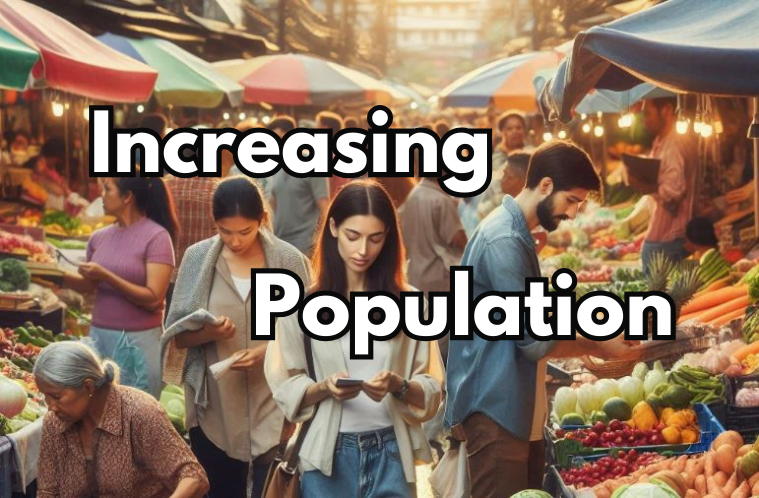An increasing world population will lead to the hustle and bustle of crowded cities extending to every corner of the globe, where resources are stretched thin, and the environment feels the strain of supporting billions more. What if the population of the world continues to increase at predicted rates? This is a question many people ponder as we navigate through the complexities of our rapidly changing world.
Why Should We Care About Population Growth?
Population growth affects everyone, from the air we breathe to the food we eat. Will there be enough resources for everyone? How will it impact the environment? What does it mean for future generations? These are the common questions and concerns that we need to address to understand the full impact of an ever-increasing global population.
How Fast Is the Population Growing?
Currently, the world population is over 8 billion and continues to grow. The United Nations predicts that by 2050, we could see the global population reach nearly 10 billion. This rapid growth is driven by factors such as higher birth rates in developing countries and increased life expectancy due to advances in healthcare.
What Are the Implications for Resources?
One of the most pressing concerns is whether there will be enough resources to sustain a larger population. Here are some areas that could be impacted:
- Food Supply: Increased population means higher demand for food. Agricultural production will need to increase significantly, but this could lead to overuse of land and water resources, potentially resulting in environmental degradation.
- Water Scarcity: Water is already a limited resource in many parts of the world. More people will exacerbate the issue, leading to increased competition for clean water.
- Energy Demand: As the population grows, so does the need for energy. This could drive up fossil fuel consumption, impacting climate change efforts unless there is a significant shift towards renewable energy sources.
How Will Population Growth Affect the Environment?
The environmental impact of population growth is significant. More people mean more waste, greater carbon footprints, and increased pressure on natural habitats. Here are some key points:
- Climate Change: Higher energy demands can lead to increased greenhouse gas emissions. Without substantial changes in energy production and consumption, the fight against climate change could become more challenging.
- Deforestation: To accommodate growing populations, forests are often cleared for agriculture and urban development. This not only destroys wildlife habitats but also reduces the planet’s ability to absorb CO2.
- Biodiversity Loss: As human activity encroaches on natural habitats, many species are at risk of extinction. This loss of biodiversity can disrupt ecosystems and the benefits they provide, such as pollination and water purification.
What About Urbanization?
Urbanization is a direct consequence of population growth. More people are moving to cities in search of better opportunities, which brings both challenges and opportunities.
- Infrastructure Strain: Cities will need to expand their infrastructure to support more residents. This includes housing, transportation, sanitation, and healthcare. Without proper planning, this can lead to overcrowded slums and increased pollution.
- Economic Opportunities: On the positive side, urbanization can drive economic growth. Cities are often hubs of innovation and employment. However, it’s essential to ensure that the growth is inclusive and benefits all residents.
How Can We Manage Population Growth Sustainably?
Managing population growth sustainably requires a multifaceted approach. Here are some strategies that can help:
- Education and Empowerment: Education, especially for women, is one of the most effective ways to reduce birth rates. When women have access to education and employment opportunities, they tend to have fewer children.
- Family Planning Services: Providing access to family planning services and contraception can help control population growth. This allows families to plan the number and spacing of their children.
- Sustainable Development: Promoting sustainable development practices can help ensure that resources are used efficiently. This includes investing in renewable energy, sustainable agriculture, and green infrastructure.
Real-Life Example: The Case of Bangladesh
Bangladesh provides a compelling example of how effective population management strategies can make a difference. In the 1970s, Bangladesh had one of the highest birth rates in the world. However, through extensive family planning programs, education, and women’s empowerment initiatives, the country has significantly reduced its fertility rate. This has not only improved living standards but also helped manage resource use more effectively.
What Can We Do as Individuals?
While large-scale policies are essential, individual actions also matter. Here are some steps we can take:
- Reduce, Reuse, Recycle: Minimizing waste helps conserve resources and reduces the environmental footprint.
- Support Sustainable Practices: Choose products and services that are environmentally friendly and support companies that prioritize sustainability.
- Educate and Advocate: Raising awareness about the impacts of population growth and advocating for policies that promote sustainability can make a significant difference.
What’s the Outlook for the Future?
The future will depend on how we address the challenges of population growth today. If we continue to grow at the predicted rates without making significant changes, we could face severe resource shortages, environmental degradation, and social challenges. However, with proactive measures, innovation, and global cooperation, we can manage population growth in a way that ensures a sustainable and prosperous future for all.






